By Jeffrey A. Rendall
Golf architect Tom Fazio says he played more golf last year (2009) than he’d played in the previous five years combined – due in part to the fact that his son has taken over the day-to-day operations of his design company, but also because there simply isn’t as much work in designing golf courses these days – at least in the United States.
The same could be said of any number of course designers we’ve heard from recently, from Greg Norman (at the British Open) to Jack Nicklaus to Bill Coore (Ben Crenshaw’s design partner) – they’ve all said in one way or another that the domestic golf course design business has virtually evaporated.
The downturn in construction has coincided with the fall of the housing market – and the two are inexorably linked. Simply put, if people aren’t buying homes, developers aren’t going to be building them to border golf courses – and if they’re not building new houses, they’re not going to be building new golf courses to prop up the communities.
There’s no doubt that the golf industry has been hit hard by the world’s financial problems – and no sector is immune. The professional Tours are losing sponsors and tournaments; resorts are losing business travel and are struggling just to survive; equipment manufacturers have seen sales demonstrably fall, leading to lay-offs and potential bankruptcies, and finally, upscale courses are feeling the hurt, forcing many to slash prices considerably to try and entice players to fill up their tee sheets.
The depressed economic situation can’t be helping the game grow, either, as polls have shown that the high cost of playing golf is a deterrent to people even trying to take up the game.
As dire as it all seems, Fazio says he’s seen similar phases before, and thinks the market for golf – and golf courses – will eventually straighten itself out, even if the ‘boom’ days of the past decade and change are probably long gone. In a way, it’s almost like the natural way of things, and Fazio’s taking a decidedly realistic tone towards the subject.
We caught up with Fazio recently, and here’s what he had to say about the current state of the golf industry:
GTMA: First off, what was it like to ‘pass the torch’ in your design firm to your son Logan?
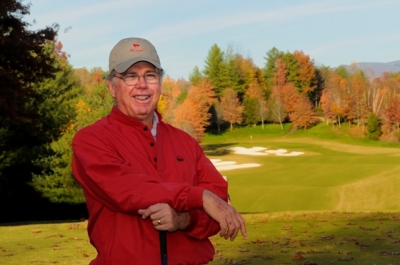 |
| Tom Fazio at The Cliffs at Keowee Vineyards 10-year anniversary event held last fall. |
Fazio: When I went from North Carolina to my office in Florida last year – I walk in, and I have this great view overlooking the Intracoastal Waterway – right in Jupiter, and you can see the ocean from a distance. In fact, I can see Tiger Woods’ new house on Jupiter Island. I walk in and I see all the furniture’s gone in my office, the pictures are down, and it’s rearranged.
I said to my son, ‘what’s the deal here?’ He says ‘Dad, you appointed me president of the company – I need this room. You don’t need to do the work, I need the space.’ He told me I had an office in the back. I went back there and he’d converted a small, closet into an office and that’s my space now.
If any other employee would’ve done that, I would’ve fired him in a minute. But it’s my son, so I couldn’t do it. He said ‘why don’t you go play golf today.’ That’s exactly the attitude – you can’t train somebody to do it, or tell somebody to do it – you need somebody to take the initiative, so that’s what he does, fortunately for me.
So I go to Jupiter Hills, Seminole, McArthur and The Floridian, five days a week now, one of those four places. It’s perfect for me.
There were a lot of years where I didn’t get to play very much, being as busy as I was and raising six kids. I even went to Pebble Beach several times a year for a couple years in a row, and wouldn’t play at all.
Nobody has to feel sorry for me, I’m doing pretty well. I’ve enjoyed the last period of time playing golf and visiting with a lot of old friends and clients and now as the economy is looking better, I’m looking forward to working with my staff in creating new courses not only in the US but around the world. I’ve had a nice little vacation and now I’m anxious and ready to go to the next phase.
GTMA: Glad to hear it. I attended a Grand Opening with Jack Nicklaus not too long ago – it sounds like he’s enjoying ‘retirement’ too – but one of the questions he was asked concerned the state of the golf industry, and I’d also heard Greg Norman talking about it at the British Open… Both essentially said that the design business in the United States was basically non-existent right now. Do you see things getting better anytime soon?
Fazio: No. No.
And the reason for that is, we have an oversupply of golf courses. We’re not going to go back to where we were several years ago, where we had a couple hundred golf courses opening every year. Do the math, from ’92 to 2006 or 2007 – we had an average of probably 250 golf courses opening up every year. In that fifteen or so years, that’s about 3750 golf courses of some fashion or form.
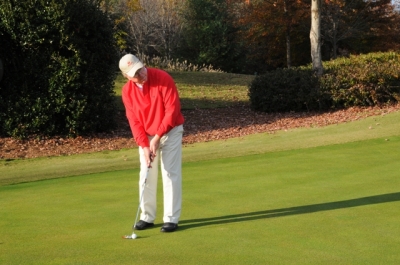 |
| Tom Fazio at The Cliffs at Keowee Vineyards. |
If you look at the marketplace, you only need so many. And if you look at the economics, we have this supply of them, and now we have to fill them up, and that’s what it’s going to take in order for there to be any demand to build more.
And now you have the housing market – it’s a combination of the chicken and the egg – you have the housing market… wherever you go, most of the golf courses have some form of housing connected to them. So you have a housing situation – and you have many, many pieces of property on the market in each one of these finished, existing properties already.
So there’s no reason to build a new one (a golf community). The reason the new ones were built – because all those other projects had been built and were sold out. So now you have to absorb all those ‘for sale’s’ that are on the market.
Then let’s talk about resorts. From a resort standpoint with the economy the way it is and the fact that corporate business is not traveling, not doing golf. I mean, you can get a tee time at St. Andrews, you can get a tee time at Pebble Beach. You can go to Pinehurst and get a tee time – so why would anybody go and build a new golf resort?
When does that change? That’s when golf changes, or there’ll be some other new things. But there’s also the economics of things, where there’s no financing for real estate development. There is no financing to build a hotel.
People don’t like hearing that and it doesn’t sound good, especially in the industry. And you can have wishful thinking, but if you get factual and in the real world, that’s the way it is.
GTMA: As far as the state of the game goes, of course golf isn’t growing (in terms of numbers) and I’ve seen polls asking about why people aren’t playing more golf. The top reasons why people aren’t playing more are because golf’s too expensive and it takes too much time. Another concern is the game is too difficult. What can be done in the industry to address those concerns?
Fazio: Well, as far as the expense side, that is definitely happening already, because prices are coming down everyplace, no matter where it is.
But unemployment is also up. Payrolls are down. I’m not sure there’s much that can be done about that – in other words, I’m not sure it’s just a golf thing. There are a lot of things that can be done about golf’s problems that are not going to happen, to some degree. When will we as golfers accept conditions that are not pristine? That’s one of the factors.
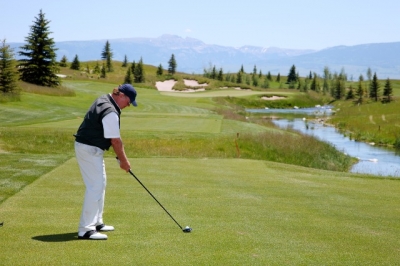 |
| Tom Fazio sizes up a tee shot at Shooting Star in Jackson Hole, Wyoming. Photo by Jonathan Adams. |
Part of the problem is due to golf journalism, too – that has added expense to the marketplace. Rankings have added expense to the marketplace. The notoriety of everything. Architects have added expense to the marketplace. Every piece of it contributes to making golf more expensive – so it just keeps putting pieces and pieces of it together. And we, as our society want more and more sophistication in the things we do.
Look at a greens superintendent. We used to have the old greens keeper – we have a sophisticated manager now, who’s very well educated and highly paid. It goes on and on and on and on, we have all those pieces – it’s America, that’s just the way it is.
Take a municipality – how can a municipality supply golf? If a municipality went out and tried to develop a piece of land, to put a golf course on it – it would cost more than a private individual doing the same thing. It’s government – it can’t be built for that. And environmental rules and regulations… you add it all together, so maybe it just can’t be done.
Does that mean you give up? I’m not saying that you give up, but these are all the factors that amount to that.
Now, if you have a golf course in your area that went into total bankruptcy, everybody loses their money, and then you start over again. Somebody buys it and opens it up. That’s a start. What they’ve done, chances are, in order to complete a business model, they’re selling their fees for less than they were. What is that number? How much lower is it? And is it low enough to generate more people to play golf?
GTMA: I talked with a Director of Golf not long ago who predicted 20% of golf facilities are going to go under in the next five years. Do you think that’s accurate?
Fazio: It’s probably possible. It’s close to it. Again, that’s a very negative way to look at it, but that’s also the real world. It’s not because golf is bad. Yeah, maybe it’s because golf is expensive – but it’s our society, it’s our timing.
Or maybe golf isn’t for everybody. Maybe we don’t need to grow the game, because it doesn’t fit.
What’s going to happen with the NFL contracts with the TV networks? Look at the media, shutting down newspapers with a 12% downturn. We’re going to have fewer writers in the newsroom, and the New York Times reduced their editorial staff by 10% or something like that. That’s just human nature, and golf fits in as part of that.
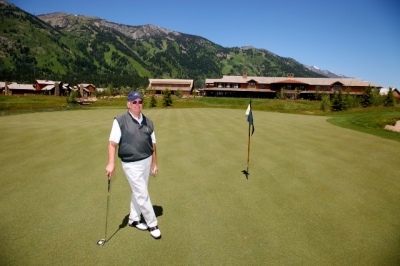 |
| At Shooting Star in Jackson Hole, Wyoming. Photo by Jonathan Adams. |
So, it’s just a new society that we’re dealing with. I don’t know what you can do about it – you can try, but with those golf courses, as you said, if somebody buys them, we’re restarting the game. Yes, people are going to lose a lot of money, whoever they are – banks, individuals, stockholders, whatever – when somebody buys it.
What can the new owners sell golf for? If greens fees were $80 or $90, and they can sell it for $45, they probably will. Maybe that’s a positive. Maybe we’re going to get a positive out of all this negativity after all, it’s just going to take awhile for that to happen.
GTMA: You’ve talked about how there was a big downturn in the early 70’s, which golf recovered from – do you think that golf’s going to recover in the near future the same way?
Fazio: I don’t know. I think it’ll recover, but to a number, to a static form of something, because what happens, when we talk about ‘recover,’ I don’t think we’re going to go back to a couple hundred golf courses being built every year.
I don’t think we’re going to go back to the boom of what we saw for a long period of time. It’s all economics – who can afford to do it, where is the capital going to come from?
It’s not politics, but it’s a way of life. If we’re going to get to more government involvement in everything, from business to individuals along the way, and there are going to be higher taxes on the ‘haves’ in our society – it’s going to cut into everything else along the way.
GTMA: The money has to come from somewhere – and the less money people have to spend, they have to sacrifice in certain areas… and golf appears to be one of them.
Fazio: Well, that’s the point. If you’re on the low end of the deal, you think that the people that ‘have’ it have too much, and golf fits into one of those categories for some people. They say, well, golf’s only for the wealthy. But you can have a fireman who loves golf – and he certainly doesn’t think he’s wealthy.
But for somebody that doesn’t have that, they think that others are living a whole lot better than they are.
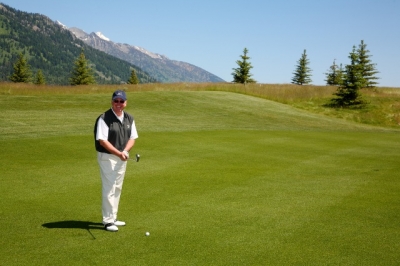 |
| At Shooting Star in Jackson Hole, Wyoming. Photo by Jonathan Adams. |
I’ve been around for forty years and I’ve seen the ups and downs – and I could see some of this coming. You just can’t have the growth that we’ve been having and the things that evolved without some sort of fallout at some point.
But we’ve also become so sophisticated in every fashion and form. You look at how we build a golf course today, and the recognition factor along the way. Of course, there are some who argue that I’m to blame for the added costs of construction and added costs to the game. (Editor’s note: Fazio was referring to Golf Digest’s Ron Whitten who wrote an article titled: Is Tom Fazio good for golf?)
Whitten’s premise was – if I’m the leader in the industry, and if I’m building these fabulous places, and people are following what I do, that obviously raises the price, so I’m the bad guy.
How ridiculous is that? But that happened. That was the theory.
So, there are some people who think just because golf is expensive… well, you can criticize Augusta National. How about Tiger Woods? What about the PGA Tour? What will happen when they have a new contract with the television? Look what’s happened to ladies’ golf – we’re going to have fewer ladies tournaments. Are we going to have fewer senior events?
Is that good for golf? Certainly not, I would say, but that’s part of it. Corporate America is not sponsoring them. It’s a change, it’s a big change and it’s a total different lay of things that are going to happen.
I don’t think it’s negative, and I don’t think it’s positive – I think it’s just the way it is.
I deal in the real world of not trying to smokescreen or wishful thinking. When you’ve done it for a long period of time… I’m not trying to sell anything. I don’t need to sell anything. I never need to design another golf course – I’d like to, because I love it – but from a feed-my-family and do your job standpoint… and a lot of people have to do their job, and hopefully they love their job and they can be in an industry that they love, but only because they have to feed their family.
GTMA: People just have a lot less disposable income. When the housing prices fell, equity evaporated and folks could no longer borrow against something that isn’t there. When you’re short on cash, golf becomes lower on the totem pole. Do you agree?
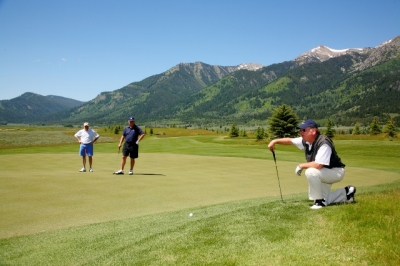 |
| At Shooting Star in Jackson Hole, Wyoming. Photo by Jonathan Adams. |
Fazio: That’s true, and that’s the chicken and the egg thing. People who had equity in their homes – and then they go and get home equity loans to buy a new car or a buy a golf membership because the membership’s going up and up. Well, then they can sell it – and they can say it didn’t cost them anything to be a member.
That’s all good, and it all makes sense, and it’s wonderful – except, the prices keep going up, and who can afford it? Eventually you have to fall off that ladder. That ladder doesn’t go to infinity, and that’s where we are. Who got caught where?
Yet they’re going to blame lots of people. They want to put the blame on Angelo Mozilo, chairman of Countrywide. Well, he started a business and was providing housing for people … and then you look at Congressman Barney Frank and the rest of them trying to provide housing for the have-nots who’ve never had housing before. All of the things fell apart. I’m not sure there are any bad guys in it all, they all had good intentions to some degree. And you add that a little greed is factored in somewhere, which everybody seems to have somewhere, and look what happened.
It just happened.
GTMA: So where do we go from here?
Fazio: I don’t see what we’re going through as being a serious problem in the big picture scheme of things. I think it’s just one of the cycles we’re in – we’re going to have these downturns and we’re going to have these problem places, but we’re going to work through it because of the oversupply. I just don’t see it all as doom and gloom.
Okay, let’s assume that not many new golf courses are going to be designed in the near future, so golf course architects – I won’t have as many golf courses to design. Well, so what? That’s just the way it is. Now, the people in the golf industry may not like that, but what’s in the real world?
That’s why my son, who is now in charge, says ‘Dad, you made me president of the company and we’re number one in the industry, and you didn’t tell me there weren’t going to be any golf courses to design.’ I said, look, what am I supposed to do? You go find the work – that’s the way I started. There weren’t many golf courses being built in the 60’s, that’s when I started.
So now he’s in Brazil. We’re doing other projects, where the work is. It just won’t be as easy. It won’t be as automatic, and there won’t be as many.
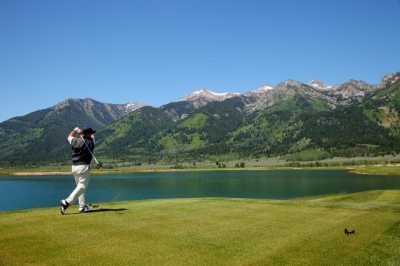 |
| At Shooting Star in Jackson Hole, Wyoming. Photo by Jonathan Adams. |
____________________________________________________________________________
In listening to Tom Fazio, it’s hard not to be at least a little optimistic about the future of golf, because he’s seen a lot throughout his career and his perspective is perhaps better than those who are merely crunching the raw (and frightening) numbers these days.
Like other segments of society, golfers have gotten a bit spoiled, with high expectations of perfect course conditions, the finest service and the convenience of living on or near a golf course.
Perhaps it’s time to take a step back and enjoy the game as it was meant to be, and remember that one way or another, this too shall pass.
Details:
| Related Links | Comments on this article? | |
|
Maryland National Golf Club Hollow Creek Golf Club Rocky Gap Resort PB Dye Golf Club in Ijamsville Whiskey Creek Golf Club |
E-mail Jeff Rendall, Editor: jrendall@golftheunitedstates.com |












